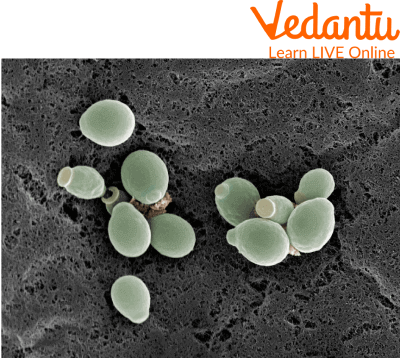




Overview of Yeast
Kids, you all love to eat bread or other bakery products. But have you ever thought about how they are made? There is an organism that helps prepare these bakery products. The organism is yeast. Yeast is a single-celled (made up of only one cell) organism. It reproduces asexually, which means it can reproduce by a single parent, and no gametes are involved. For many years yeast has been used for baking and brewing purposes.
Till now, 1500 species of yeast have been identified. It is considered in the family of fungi, like mushrooms. In this article, we will learn the uses of yeast; yeast uses in food and more about what is yeast.

Structure of Yeast
What is Yeast?
Yeast is a microorganism which is single-celled and eukaryotic. They are classified as a member of the fungus kingdom. Yeast is particularly efficient in fermentation. Some of them are harmful to humans. Some yeasts are grown to use in the food industry, and others grow naturally. Yeast can grow easily in the presence of sugar. Yeasts have various uses. It is useful in the production of many different products. Some of the common uses are:
Bread
Cakes
Biscuits
Cookies
Crackers
Flour
Milk
Buns
Hotdogs
Pastries

Use of Yeast in Alcoholic Products
Uses of Yeast
Following are some important uses of yeast:
Bread: It is the most common use of yeast. Yeasts react with oxygen and help the bread to rise. Jewish people were using yeast to make flatbread.
Alcoholic Drinks: Yeasts are used to ferment the mixture to make it alcoholic. Yeasts are useful in making ale, lager, spirits, and wine.
Non-alcoholic Drinks: Yeasts add flavours to Root beers and other soft drinks. The use of a fermentation process does this. The fermentation process is stopped before the drink becomes alcoholic.
Research: Because of their cellular makeup, yeasts are useful in various scientific research related to genetics.
Biofuel: Yeasts are used in the preparation of biofuels. As we know, yeast can turn sugar into ethanol; hence this process is used to prepare biofuels that are utilised as diesel substitutes in vehicles.
Yeast Uses in Food
Yeasts are used to produce different food items. The following are the yeast used in food:
Yeasts in Fermented Food and Beverages: Yeasts are beneficial microorganisms for producing fermented foods and beverages. Yeasts are used here to make cheese, bread, sourdoughs, fermented meats, and fermented vegetable products.
Yeasts in Dairy Products: Yeasts are used for the preparation of various dairy products. They must add flavour and texture to fermented milk like kefir and koumiss. It is also useful in ripening cheese.
Yeasts in Fermented Meat Products: Yeasts are used in limited quantities in fermented meat products. They are used for adding colours and flavours to the meat.
Yeasts in the Fermentation of ereal Products: Yeasts are used in the fermentation of cereal products to improve their life and nutritional value compared to raw products. The protein quantity is large in fermented products.

Yeast in Bread Dough
Nutritional Yeast Uses
Nutritional yeast is also known as nooch. It is a popular product that is used in vegan cooking. It is a species of yeast Saccharomyces cerevisiae. It is of two types: fortified(which contains synthetic vitamins) and unfortified(which does not contain any type of added vitamins).
The uses of nutritional yeasts are the following:
Used in the seasoning of popcorn, pasta, salad, etc.
Used as an umami flavour in soups or chilli.
Used as a savoury, cheesy flavour in vegan sauces.
Used as a thickener for soups and sauces.
Used as a pet food additive.
Used as an ingredient in smoothies.
Summary
In this article, we learned that yeasts are single-celled microorganisms that are very useful for human beings. Yeasts are useful in preparing bread, alcoholic products, non-alcoholic products, and biofuels. It is also too beneficial for scientists for genetic studies and research. It is used for flavouring vegan sauces. Yeasts are used in fermented food and beverages, dairy products, fermented meat products, and fermentation of cereal products.
Thus, we discussed how yeast is used in the production of various food and beverage industries, what is yeast, the yeast used in the food and what nutritional yeast uses.
FAQs on Uses of Yeast
1. What is yeast and why is it classified as a fungus, not a bacteria?
Yeast is a single-celled, eukaryotic microorganism. It is classified as a fungus because its cellular structure and method of reproduction are characteristic of the fungus kingdom, similar to mushrooms. Unlike bacteria, which are prokaryotic, yeast cells contain a true nucleus and other complex organelles, placing them firmly in the fungus family.
2. What are five important uses of yeast in different industries?
Yeast has several crucial industrial applications. Five important examples include:
- Baking Industry: Used as a leavening agent to make bread, cakes, and other bakery products rise.
- Brewing Industry: Essential for the fermentation process that produces alcoholic beverages like beer and wine.
- Food Production: Utilised in making fermented foods like cheese, kefir, and sourdough, as well as adding flavour to non-alcoholic drinks.
- Biofuel Production: Used to convert sugars into ethanol, which can be used as a renewable biofuel.
- Scientific Research: Serves as a model organism in genetics and cellular biology due to its simple eukaryotic cell structure.
3. How does yeast make bread dough rise?
Yeast makes bread dough rise through a process called alcoholic fermentation. When mixed into the dough, the yeast feeds on the sugars present in the flour. This metabolic process produces two main byproducts: ethanol (which evaporates during baking) and carbon dioxide gas. The bubbles of carbon dioxide get trapped within the dough's gluten network, causing it to inflate and rise, creating a light and airy texture.
4. What is the difference between the yeast used for baking and nutritional yeast?
The main difference lies in their state and purpose. Baking yeast (e.g., baker's yeast) is a live, active organism used to make dough rise. Nutritional yeast is the same species of yeast (*Saccharomyces cerevisiae*), but it has been deactivated with heat and is no longer alive. It is used as a food supplement and seasoning, valued for its savoury, cheesy flavour and high nutrient content, particularly B vitamins.
5. How is yeast used to produce alcoholic beverages like wine and beer?
In the production of alcoholic beverages, yeast performs fermentation on sugary liquids. For wine, yeast is added to grape juice, and for beer, it's added to a mixture of malted grains and water. The yeast consumes the natural sugars and converts them into ethanol (alcohol) and carbon dioxide, transforming the juice or grain mixture into an alcoholic drink.
6. Why is yeast an important model organism in scientific research?
Yeast is a valuable tool for scientists because it is a simple, single-celled eukaryote. This means its cells share many fundamental characteristics with human cells, including having a nucleus, mitochondria, and a similar cell division cycle. Its rapid growth and simple genetics allow researchers to study complex biological processes like ageing, DNA repair, and cancer in a much faster and more manageable system.
7. Besides making bread, what are other applications of yeast in food preparation?
Beyond baking, yeast is used in various ways in the food industry. It is key for fermenting dairy products to create kefir and koumiss, adds flavour and aids in the ripening of certain cheeses, is used in the fermentation of vegetables, and contributes flavour to non-alcoholic drinks like root beer through a controlled fermentation process.
8. Can yeast be harmful to the human body?
While the yeasts used in food production, like baker's and brewer's yeast, are safe and beneficial, certain species of yeast can be harmful. These are known as opportunistic pathogens. For example, the yeast Candida albicans, which can live in the human body, may cause infections (candidiasis) if the immune system is weakened, leading to health issues.









